Bit once fell below the $77,000 mark this week and is currently fluctuating around $80,000. The market seems to have entered another "pullback moment". Faced with the ups and downs of the price, I believe many friends are pondering the same question:
Is it now time to "get off the car and hedge" or "buy the dip"?
This question may seem simple, but it is actually complex. Especially in the crypto market, the short-term volatility is intense, and various information noises are intertwined, which can easily make people lose their direction. When we are in the "pullback moment", we need a calm thinking to detach ourselves from the price fluctuations in front of us and examine them in the broader framework of "trends" and "cycles".
Indeed, whether this "car" of Bit can continue to move forward is a common concern for all "passengers". But as we will discuss today, within the "above the trend, between the cycles", there are key clues to the answer to this question.
Today, I will use the framework of "trends and cycles" to help you clear the fog and have a cool-headed reflection on the "pullback moment" of Bit. First, let's start with understanding the basic concepts of "trends" and "cycles".
A picture is worth a thousand words. The chart below can give us a quick intuitive understanding of "trends" and "cycles". Please note that the vertical axis of the chart is a logarithmic scale, where the height from 0 to 1 is equal to the height from 1 to 10, which is to see the price changes in the early stage more clearly.
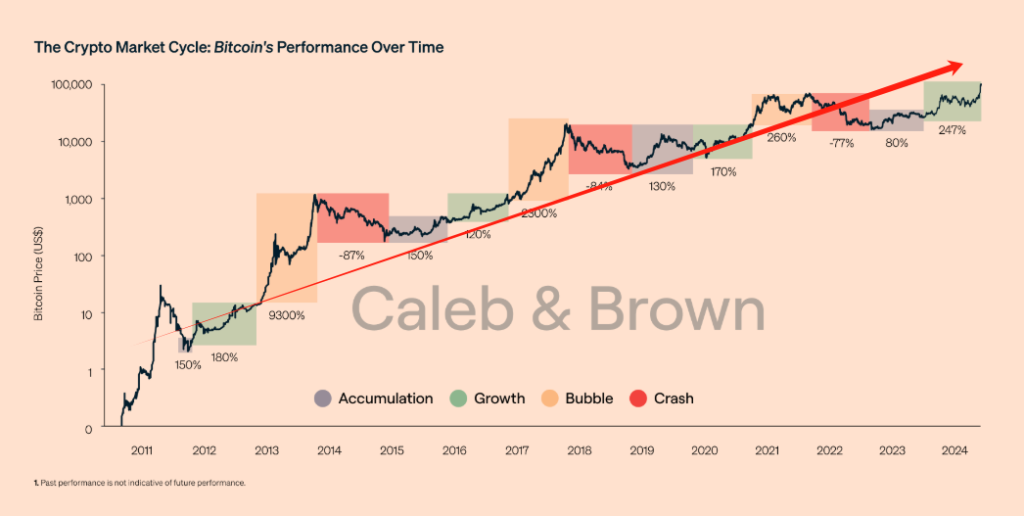
- Trend: The upward red arrow. Represents the long-term upward trend of Bit's price. Will this trend continue? This is the key question we will answer today, and several important long-term indicators will give you confidence in Bit's future.
- Cycle: The four colored blocks. They represent the different stages of a cycle. The stages of the first 3 cycles are relatively clear, but the division of the fourth stage starting from 2023 is not only incomplete, but also highly controversial. This is also what we need to explain to you today. An important contrarian indicator should make it easy for you to make the decision to "get on board".
Through the above chart, I believe you should have a more intuitive perception of trends and cycles. Now let's come to understand what trends and cycles are in detail.
1. What are trends and cycles?
To understand any market, we should first distinguish the two key concepts of "trends" and "cycles", and the crypto market is no exception.
- Trend: Trend is the long-term direction of the development of things, which is a grand and lasting force. It represents the most essential and core direction of things, like a surging river, once formed, it is difficult to reverse.
- Cycle: Cycle is the short-term fluctuation in the development process of things, which is a rhythmic change that fluctuates up and down around the trend line.
In simple terms, the cycle is within the trend. However, this simple inclusion is not enough to express the complex relationship between them. If we compare "trend" to the trunk of a tree, then "cycle" would be like the annual rings on the trunk.

Just as the trunk of a tree determines how high it can ultimately grow and in what direction, the growth of a tree is not smooth sailing, it will be affected by factors such as seasons, climate, and soil fertility, and these influences will leave "annual rings" on the trunk.
By analogy to the Bitcoin market:
- The long-term trend of Bitcoin is shaped by macro factors such as technological innovation, global adoption, institutional participation, and policy evolution, which determine the long-term upward or downward direction of Bitcoin prices. Once this trend is formed, it is like a surging river, and although the road ahead may be winding, it is difficult to change its ultimate direction of flowing into the sea.
- The short-term cycle of Bitcoin is affected by factors such as market sentiment, macroeconomic conditions, unexpected events, and capital flows, like the rolling waves in the river, although they are turbulent and magnificent, they are ultimately temporary phenomena in the long-term trend of the river. In the Bitcoin market, the alternation of bull and bear markets, the short-term price fluctuations, all belong to the category of cycles.
However, many times we cannot distinguish what is a trend and what is a cycle. Why is that?
2. Why is it not easy to distinguish "Trend and Cycle"?
The reason is simple, but deeply rooted in human nature and the complexity of the market.
The human brain is naturally more sensitive to "changes", especially short-term and dramatic changes. Imagine standing in a forest, the first things that catch your eye are the swaying leaves in the wind and the jumping squirrels on the branches, not the majestic century-old tree standing tall. Similarly, in the "digital forest" of cryptocurrencies, our brains are more easily attracted to daily price fluctuations, the "waves" in the short term, and ignore the long-term "river" - the long-term trend.
Especially in the Bitcoin market, the volatility is so extreme that it can be called a "digital ocean" with "storms and heavy rains". Prices can surge or plummet 10% or even 20% in a single day, which is commonplace. Under such violent fluctuations, the investor's brain is like a small boat in the raging waves, constantly being hit by the towering waves, where would there be time to care about the vast ocean currents?
Moreover, human nature is inherently averse to loss and inclined to seek gains and avoid harm. When prices fall and accounts shrink, the instinct of "loss aversion" will make us extremely anxious, just wanting to "stop loss" and get out of the market, where would we care about the "long-term trend"? And when prices soar, the desire for "greed" will drive us to enter the market because of FOMO (Fear of Missing Out), afraid of missing the opportunity to "get rich", and we won't calmly think about whether this is the power of the trend or just the pulsation of the cycle.
Even more puzzling is that the cyclical fluctuations in the Bitcoin market are often highly deceptive, they often "change faces" and disguise themselves as "trend reversals", making it difficult to distinguish the true from the false and see the real truth behind it.
Even more complex is that the Bitcoin market is full of all kinds of "noise" information, and this "noise" is like a "mist" that interferes with our judgment and makes it difficult for us to capture the real "signal" - the guidance of the long-term trend.
Even worse, much of the "noise" information is often artificially created, released by "market makers" or "institutions" as "smoke screens" to confuse and mislead retail investors for their own nefarious purposes. For example, when the market is falling, they will spread all kinds of FUD (Fear, Uncertainty, Doubt) information to create a panic mentality and induce retail investors to sell at low prices; and when the market is rising, they will release various optimistic messages to create a pleasant atmosphere and attract retail investors to buy at high positions.
So it's understandable that sometimes we can't tell whether the current decline is a "cyclical pullback" or a "reversal of the trend".
So what is the current situation of Bitcoin?
A cyclical pullback.
In fact, this answer hides an important premise - the overall upward trend of Bitcoin has not changed. Is that really the case? This may be the biggest question in your mind. So we should first clarify this issue. Because only by first figuring out where the "ship" is heading can you decide whether you should get on board.
3. Why hasn't the upward trend of Bitcoin changed?
The answer lies in those grand and lasting forces, the foundations that shape Bitcoin's long-term trend. Even in the mist of short-term market pullbacks, these foundations remain as solid as a rock, shining with the direction of the trend.
3.1 Global Adoption: 96% "No Man's Land" Indicates Vast Growth Potential
By 2025, only 4% of the world's population will own Bitcoin.
This data may seem disappointing at first glance, but looking at it from a different angle, it contains an incredibly growth potential!
Imagine a huge market with a population of billions, with only 4% developed so far, and 96% "no man's land" waiting for us to explore and cultivate. Isn't this an exciting "blue ocean" market?
A research report from River also confirms this: Bitcoin has realized less than 4% of its maximum adoption potential. This means that the path to global Bitcoin adoption is still in its "infancy", the road ahead is still long, and the growth potential is extremely broad.
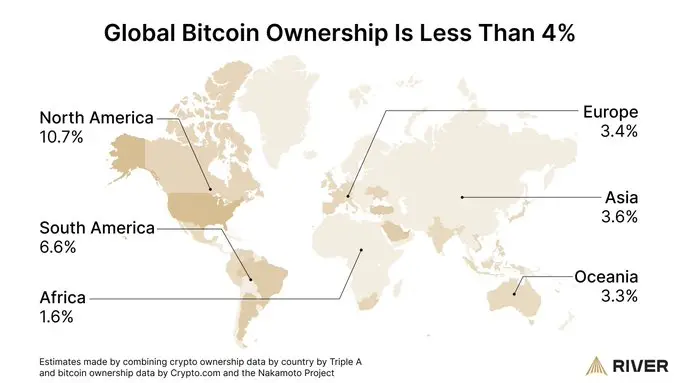
Particularly noteworthy is that developing countries and regions will be the main driving force for the future growth of Bitcoin adoption. The report shows that North America is currently the region with the highest Bitcoin adoption rate, while the adoption rate in Africa is only 1.6%. This precisely indicates that Bitcoin still has huge room for popularization in economically underdeveloped regions.
So what does this slightly more than 3% global adoption rate mean? River's report provides an analogy, as shown in the figure below.

This low adoption rate is equivalent to the Internet in 1990, online banking in 1996, and social media in 2005. In other words, this is an era full of opportunities. Even if you haven't boarded the ship yet, it's not too late. Taobao was not the first to do e-commerce, Google was not the first to do search, and Netflix was not the first to do online video.
Everything is just beginning. This 96% "no man's land" will be the most solid "demographic dividend" for the long-term upward trend of Bitcoin!
3.2 Three Driving Forces: Institutional Participation + Clear Regulation + National Reserves
Bitcoin, which was once "sneered at" by traditional financial institutions, has now become the "delicacy" they are vying for.
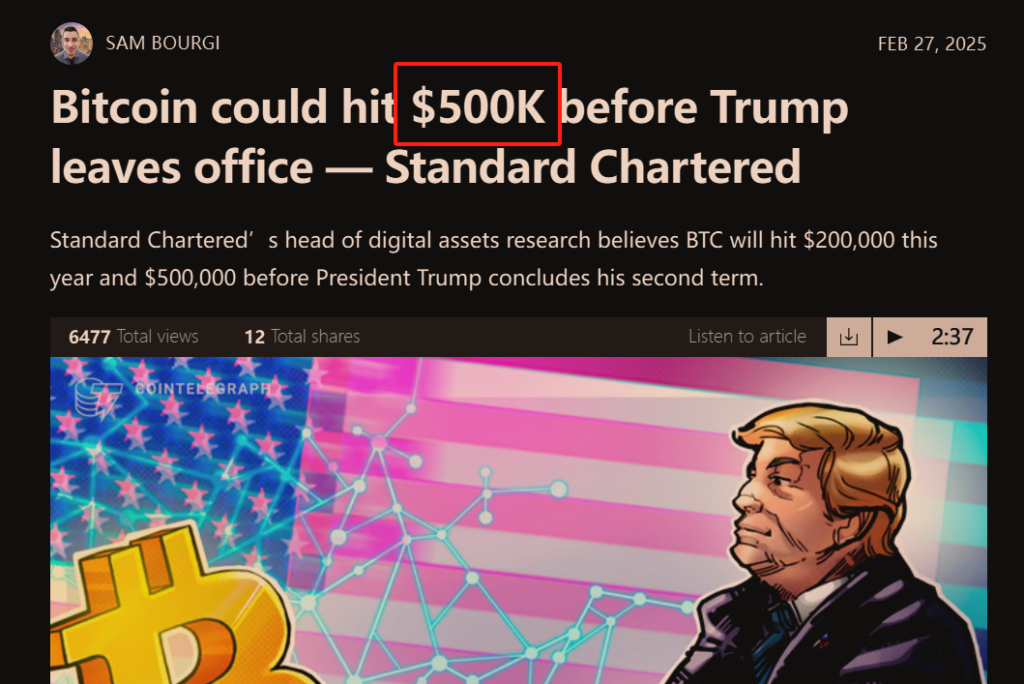
Standard Chartered Bank predicts that the price of Bitcoin will reach $500,000 during Trump's term, and explicitly pointed out that "the growth of institutional adoption" is one of the key driving factors. Geoffrey Kendrick, head of digital assets research at Standard Chartered Bank, believes that the participation of institutions will not only reduce the volatility of the cryptocurrency market, but also enhance the security of the market. In addition, Standard Chartered is the only institution that has accurately predicted the current bottom of Bitcoin - $69,000 to $76,500.
Standard Chartered believes that another driving factor is the establishment of a clearer regulatory framework in the United States.
The Trump administration not only established a "strategic Bitcoin reserve", but is also actively promoting stablecoin legislation. U.S. Congressman Bryan Steil publicly stated that the United States has huge legislative opportunities in blockchain technology, Web3, and cryptocurrencies. Steil currently serves as the chairman of the U.S. House Subcommittee on Digital Assets, Financial Technology and Inclusion.
CoinShares' research report also points out that the establishment of a strategic Bitcoin reserve in the United States will have a more far-reaching long-term impact on Bitcoin adoption than the launch of ETFs. The current market severely underestimates the value of the U.S. strategic Bitcoin reserve, and is more trapped in short-term liquidity. For a more detailed interpretation, I recommend you read "Digital Normandy: The White House's Plot to Lock Up 190,000 Bitcoins".
In Europe, banks like DekaBank have started to support cryptocurrency trading, and Boerse Stuttgart Digital is also actively promoting institutional-level applications of cryptocurrencies. All of this indicates that institutional capital is accelerating its influx into the Bitcoin market, and traditional financial giants are "running to get on board".
As regulatory policies become increasingly clear, the share of institutions and countries holding Bitcoin will become larger and larger, becoming the dominant force driving the long-term rise in Bitcoin prices.
3.3 Macroeconomic Improvement: PMI and M2 Pointing to "Positive Reversal"
Although in the short term, the Trump administration's tariff policy and the strengthening of the U.S. dollar index have brought certain "headwinds" to the Bitcoin market, from a more macro-economic and policy perspective, the long-term upward trend of Bitcoin is still strongly supported.
U.S. manufacturing PMI has been in expansion mode (greater than 50) for two consecutive months, which is seen as a signal of "positive reversal of the business cycle". Real Vision founder Raoul Pal pointed out that PMI leads the economy by about a month. Moreover, it not only leads the economy, but leads all assets. He believes that with the upswing of the business cycle, Bitcoin is expected to peak by the end of 2025 or even the beginning of 2026.
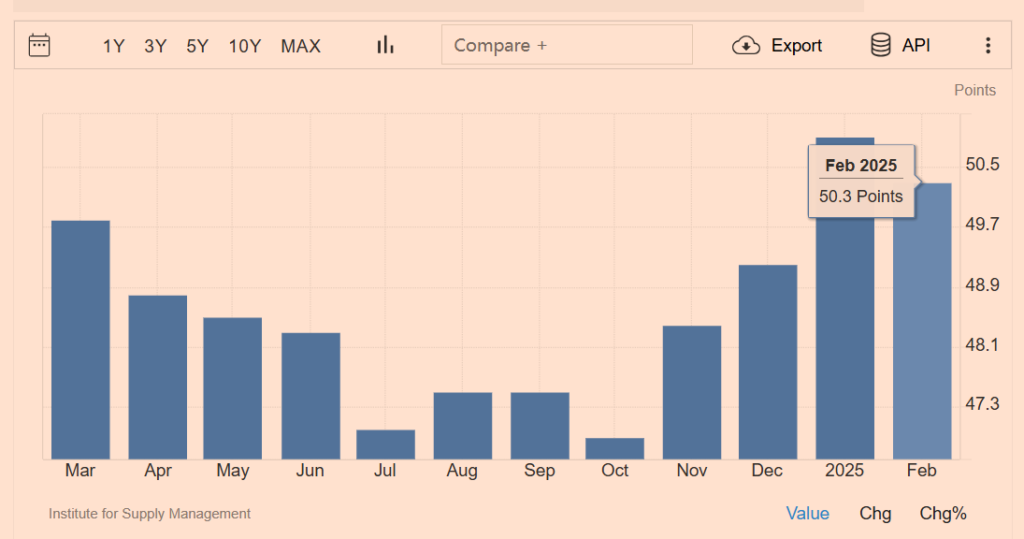
S&P Global Market Intelligence's research supports Pal's view, as shown in the figure below. You will find that when the PMI on the right side is greater than 50, GDP will generally show varying degrees of growth. The research believes that PMI data has predicted "every turning point in earnings over the past 14 years".
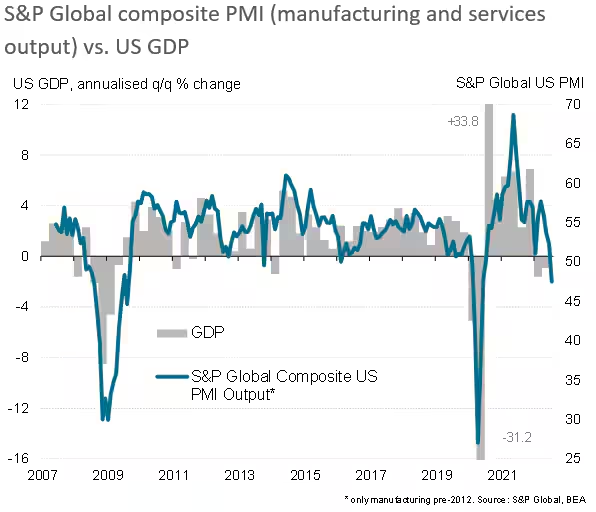
Another indicator worth noting - global M2 money supply - has also shown a "sharp upward" trend. Real Vision's research shows that Bitcoin prices usually reflect changes in global M2 within about 10 weeks.

Analyst Colin Talks Crypto has even precisely calculated the "46-day and 72-day lags" of the impact of changes in global M2 on Bitcoin prices through data analysis. Lyn Alden also pointed out that "Bitcoin has co-moved with global liquidity 83% of the time over any given 12-month period, making it a powerful barometer of liquidity conditions".
This means that the improvement in global macro liquidity will provide a strong "boost" for the rise in the price of Bitcoin.
3.4 Summary: The Three Pillars of Bitcoin's Long-Term Trend
The long-term upward trend of Bitcoin has not changed, and the core support comes from three irreversible macro forces:
- 96% blue ocean market: Currently, only 4% of the global population holds Bitcoin, and the adoption rate in developing countries is less than 2%, which is equivalent to the Internet in the 1990s, with far greater growth potential than short-term market fluctuations.
- Institutional and national strategic entry: Standard Chartered Bank predicts that Bitcoin may reach $500,000 during Trump's term, the US is establishing a "strategic Bitcoin reserve" and accelerating stablecoin legislation, and European banks like DekaBank have already opened up cryptocurrency trading, forming a "institutional + regulatory + sovereign reserve" triple thrust.
- Macro cycle resonance: The continuous expansion of the US PMI indicates a reversal of the business cycle, and the 46-72 day lagged correlation between global M2 growth rate and Bitcoin price, with loose liquidity and Bitcoin's "digital gold" attribute forming long-term synergy.
Therefore, the short-term pullback to $77,000 is just a wave of the cycle, and the trend of the river is still surging forward. So, is the price of $77,000 the bottom? Is this a good time to enter the market?
In fact, if you recognize the arguments I made about the trend above, the answer is self-evident. Although you may not be able to buy at the lowest point, you will not buy at the high point either. The only thing you need to control is your own desire, and don't use too much leverage.
Epilogue: Be Friends with Time, Dance with Trends
History does not repeat itself, but it always rhymes. When gold flowed from the Americas to Europe, it created the wealth myth of the Age of Discovery; when the Internet went from the laboratory to every household, it reshaped the way human civilization is connected - today, we are standing at the forefront of the digital asset revolution, witnessing the epic transition of Bitcoin from code to a global value carrier.
When 96% of the global population has not yet held Bitcoin, when sovereign wealth funds begin to include crypto assets on their balance sheets, and when blockchain technology becomes the new battlefield for major powers - this speeding "digital ark" has just set sail from the shipyard that built it.
The secret to dancing with trends is not to predict the shape of the waves, but to understand the rhythm of the tides. Those investors who stood firm with Amazon during the Internet bubble burst, and the visionaries who heavily invested in Apple during the dawn of mobile Internet, all knew a truth: Trends are not smooth straight lines, but upward spirals composed of countless cyclical oscillations. Just like the $77,000 fluctuation at this moment, it is just a brief chord in the symphony of the crypto civilization, and the main melody is still rising towards the high ground of trust built by hash power.
True dancers never need spotlights to illuminate the entire path. When 96% of the audience are still watching from the sidelines, and when sovereign wealth funds begin to adjust the rhythm of their dance steps, the wise have already marked their own notes on the blockchain score - they may step on the wrong beat, they may stumble briefly, but as long as their feet are firmly on the tectonic plate of the technological revolution, they will witness the recombination of the financial continental shelf.
Trends are the sea, cycles are the boat, fools calculate the height of the waves, and the wise calibrate the angle of the sails. Trends determine the overall direction of the market, while the fluctuations of cycles are short-term phenomena that rise and fall along the trends. When the dusk of the fiat system meets the dawn of the crypto economy, instead of chasing shadows in the K-line maze, it is better to plunge into the torrent of digital civilization and board the ark that is lifted by the waves of the times.
Every pullback at this moment is a ticket that history has reserved for the awakened.







